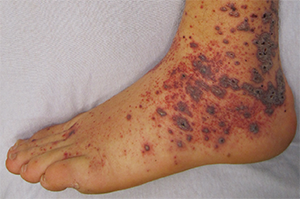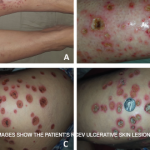
Petechia/purpura on the low limb due to medication induced vasculitis.
James Heilman, MD/wikipedia.com
WASHINGTON, D.C.—The vast majority of the attention given to vasculitis at the ACR/ARHP Annual Meeting, year after year, focuses on ANCA-associated vasculitis and large-vessel vasculitis, said Philip Seo, MD, MHS, director of the Johns Hopkins Vasculitis Center and moderator of the 2016 ACR Review Course titled, Neglected Vasculitis. That leaves out a lot.
“These are important diagnoses,” Dr. Seo said. “There have been a lot of advances made over the last several years. But does that mean there are lot of forms of vasculitis out there that you are going to run into on a regular basis that don’t get any love from the ACR? It’s hard to have an opinion about diagnoses that you don’t see on a daily basis.”
Dr. Seo described some of the ins and outs of three vasculitis forms that are less common: IgA vasculitis (formerly known as Henoch-Schönlein purpura), polyarteritis nodosa and urticarial vasculitis.
IgA Vasculitis
The formal classification criteria for IgA vasculitis require the presence of purpura or petechiae unrelated to thrombocytopenia, predominantly in the lower limbs, with at least one of the following additional manifestations: arthritis or arthralgias, renal involvement, abdominal pain or evidence of IgA predominance on histopathology.
Dr. Seo cautioned that IgA vasculitis and IgA nephropathy are not necessarily the same thing, even though they come with roughly the same risk of renal failure. That “could be right, I’m just not sure,” he added. “I’m willing to say that these diagnoses are similar.”
Both IgA vasculitis and IgA nephropathy can be secondary to other disorders, which is “really important to keep in mind” because sometimes the primary diagnosis is treatable, he added. IgA nephropathy can be secondary to alcoholic cirrhosis, celiac disease, Crohn’s disease and chronic infection, among other things. By contrast, IgA vasculitis can be secondary to infection or the use of certain drugs, such as ciprofloxacin, aspirin, vancomycin or even cocaine.
Treatment options: Patients with IgA vasculitis presenting with colitis can be offered short courses of steroids. For patients with glomerulonephritis, the data don’t show any lasting benefit from cyclophosphamide, mycophenolate mofetil, azathioprine or cyclosporine. There may be a short-term benefit from steroids, but they probably won’t change long-term outcomes, Dr. Seo said. Rituximab is an option, but Dr. Seo said he hasn’t seen very impressive results. For purpura, dapsone is the top option, but not all patients will need the full 100 mg dose, he emphasized.
Polyarteritis Nodosa
Cutaneous polyarteritis nodosa (cPAN) is a form of polyarteritis nodosa that is limited to the skin. Patients can present with livedo racemosa, a violet-toned, net-like pattern on the skin, when more superficial vessels are affected. Cutaneous nodules can present when deeper vessels are more affected.


